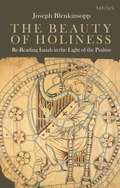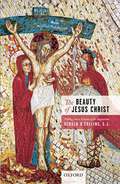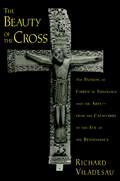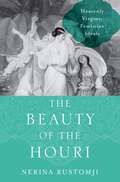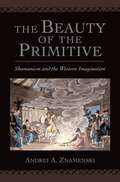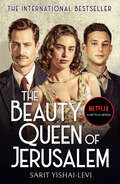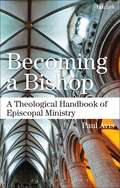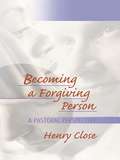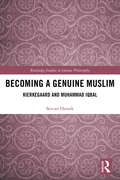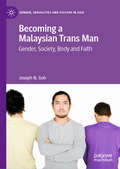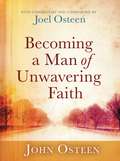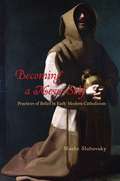- Table View
- List View
The Beauty of Holiness: Re-Reading Isaiah in the Light of the Psalms
by Joseph BlenkinsoppJoseph Blenkinsopp presents an intertextual reading of Isaiah and the Psalms furthering his previous well-known work on the text of Isaiah. Blenkinsopp argues that, read together, these two biblical books can be shown to form a single religious vision, a way of experiencing and articulating a commitment to the fundamentals of the faith of Israel, with its own distinctive character. Blenkinsopp shows how the emphasis in Isaiah and the Psalms is on affect and emotion, the expression of joy and sorrow articulated in music, singing, and dancing; in praise, thanksgiving and lament. This represents a key difference from other parts of the Hebrew Bible where the focus is more on the Law and on the covenant at Sinai – in Isaiah and the Psalms these terms rarely occur, the focus is instead on Zion and on the Temple. Blenkinsopp shows how the temple singers, with their close connections with the circles which transmitted and eventually committed to writing the Book of Isaiah, demonstrate that the divine word is not incompatible with other forms of religious experience and expression, affective and even mystical, articulated and embodied in the performance of music, song, ritual prayer, and dance. The beauty of the Psalms is echoed strongly in Isaiah, and the Isaian vision of a Creator God, Lord of nature and history beyond the bounds of Israel, is joyfully proclaimed by the psalmists.
The Beauty of Holiness: Re-Reading Isaiah in the Light of the Psalms
by Joseph BlenkinsoppJoseph Blenkinsopp presents an intertextual reading of Isaiah and the Psalms furthering his previous well-known work on the text of Isaiah. Blenkinsopp argues that, read together, these two biblical books can be shown to form a single religious vision, a way of experiencing and articulating a commitment to the fundamentals of the faith of Israel, with its own distinctive character. Blenkinsopp shows how the emphasis in Isaiah and the Psalms is on affect and emotion, the expression of joy and sorrow articulated in music, singing, and dancing; in praise, thanksgiving and lament. This represents a key difference from other parts of the Hebrew Bible where the focus is more on the Law and on the covenant at Sinai – in Isaiah and the Psalms these terms rarely occur, the focus is instead on Zion and on the Temple. Blenkinsopp shows how the temple singers, with their close connections with the circles which transmitted and eventually committed to writing the Book of Isaiah, demonstrate that the divine word is not incompatible with other forms of religious experience and expression, affective and even mystical, articulated and embodied in the performance of music, song, ritual prayer, and dance. The beauty of the Psalms is echoed strongly in Isaiah, and the Isaian vision of a Creator God, Lord of nature and history beyond the bounds of Israel, is joyfully proclaimed by the psalmists.
The Beauty of Jesus Christ: Filling out a Scheme of St Augustine
by Gerald O'Collins, S.J.This book anchors its account of the beauty of Jesus Christ to a scheme found in St Augustine of Hippo's Expositions of the Psalms. There Augustine recognized the beauty of Christ at every stage-from his pre-existence ('beautiful in heaven'), through his incarnation, the public ministry ('beautiful in his miracles, beautiful in calling to life'), passion, crucifixion, burial, resurrection ('beautiful in taking up his life again'), and glorious life 'in heaven'. Augustine never filled out this laconic summary by writing a work on Christ and his beauty. The Beauty of Jesus Christ seems to be the first attempt in Christian history to write a comprehensive account of the beauty of Christ in the light of Augustine's list. The work begins by offering a working description of what it understands by beauty as being perfect, harmonious, and radiant. Beauty, above all the divine beauty, enjoys inexhaustible meaning and overlaps with 'the holy' or the awesome and fascinating mystery of God. Loving beauty opens the way to truth and helps us grasp and practise virtue. The books needs to add some items to Augustine's list by recognizing Christ's beauty in his baptism, transfiguration, and post-resurrection sending of the Holy Spirit. It also goes beyond Augustine by showing how the imagery and language Jesus prepared in his hidden life and then used in his ministry witness to the beautiful sensibility that developed during his years at home in Nazareth. Throughout, this book draws on the Scriptures to illustrate and justify Augustine's brief claims about the beauty revealed in the whole story of Christ, from his pre-existence to his risen 'post-existence'. Where appropriate, it also cites the witness to Christ's beauty that has come from artists, composers of sacred music, the creators of icons, and writers.
The Beauty of Jesus Christ: Filling out a Scheme of St Augustine
by Gerald O'Collins, S.J.This book anchors its account of the beauty of Jesus Christ to a scheme found in St Augustine of Hippo's Expositions of the Psalms. There Augustine recognized the beauty of Christ at every stage-from his pre-existence ('beautiful in heaven'), through his incarnation, the public ministry ('beautiful in his miracles, beautiful in calling to life'), passion, crucifixion, burial, resurrection ('beautiful in taking up his life again'), and glorious life 'in heaven'. Augustine never filled out this laconic summary by writing a work on Christ and his beauty. The Beauty of Jesus Christ seems to be the first attempt in Christian history to write a comprehensive account of the beauty of Christ in the light of Augustine's list. The work begins by offering a working description of what it understands by beauty as being perfect, harmonious, and radiant. Beauty, above all the divine beauty, enjoys inexhaustible meaning and overlaps with 'the holy' or the awesome and fascinating mystery of God. Loving beauty opens the way to truth and helps us grasp and practise virtue. The books needs to add some items to Augustine's list by recognizing Christ's beauty in his baptism, transfiguration, and post-resurrection sending of the Holy Spirit. It also goes beyond Augustine by showing how the imagery and language Jesus prepared in his hidden life and then used in his ministry witness to the beautiful sensibility that developed during his years at home in Nazareth. Throughout, this book draws on the Scriptures to illustrate and justify Augustine's brief claims about the beauty revealed in the whole story of Christ, from his pre-existence to his risen 'post-existence'. Where appropriate, it also cites the witness to Christ's beauty that has come from artists, composers of sacred music, the creators of icons, and writers.
The Beauty of the Cross: The Passion of Christ in Theology and the Arts from the Catacombs to the Eve of the Renaissance
by Richard ViladesauFrom the earliest period of its existence, Christianity has been recognized as the "religion of the cross." Some of the great monuments of Western art are representations of the brutal torture and execution of Christ. Despite the horror of crucifixion, we often find such images beautiful. The beauty of the cross expresses the central paradox of Christian faith: the cross of Christ's execution is the symbol of God's victory over death and sin. The cross as an aesthetic object and as a means of devotion corresponds to the mystery of God's wisdom and power manifest in suffering and apparent failure. In this volume, Richard Viladesau seeks to understand the beauty of the cross as it developed in both theology and art from their beginnings until the eve of the renaissance. He argues that art and symbolism functioned as an alternative strand of theological expression -- sometimes parallel to, sometimes interwoven with, and sometimes in tension with formal theological reflection on the meaning of the Crucifixion and its role insalvation history. Using specific works of art to epitomize particular artistic and theological paradigms, Viladesau then explores the contours of each paradigm through the works of representative theologians as well as liturgical, poetic, artistic, and musical sources. The beauty of the cross is examined from Patristic theology and the earliest representations of the Logos on the cross, to the monastic theology of victory and the Romanesque crucified "majesty," to the Anselmian "revolution" that centered theological and artistic attention on the suffering humanity of Jesus, and finally to the breakdown of the high scholastic theology of the redemption in empirically concentrated nominalism and the beginnings of naturalism in art. By examining the relationship between aesthetic and conceptual theology, Viladesau deepens our understanding of the foremost symbol of Christianity. This volume makes an important contribution to an emerging field, breaking new ground in theological aesthetics. The Beauty of the Cross is a valuable resource for scholars, students, and anyone interested in the passion of Christ and its representation.
The Beauty of the Cross: The Passion of Christ in Theology and the Arts from the Catacombs to the Eve of the Renaissance
by Richard ViladesauFrom the earliest period of its existence, Christianity has been recognized as the "religion of the cross." Some of the great monuments of Western art are representations of the brutal torture and execution of Christ. Despite the horror of crucifixion, we often find such images beautiful. The beauty of the cross expresses the central paradox of Christian faith: the cross of Christ's execution is the symbol of God's victory over death and sin. The cross as an aesthetic object and as a means of devotion corresponds to the mystery of God's wisdom and power manifest in suffering and apparent failure. In this volume, Richard Viladesau seeks to understand the beauty of the cross as it developed in both theology and art from their beginnings until the eve of the renaissance. He argues that art and symbolism functioned as an alternative strand of theological expression -- sometimes parallel to, sometimes interwoven with, and sometimes in tension with formal theological reflection on the meaning of the Crucifixion and its role insalvation history. Using specific works of art to epitomize particular artistic and theological paradigms, Viladesau then explores the contours of each paradigm through the works of representative theologians as well as liturgical, poetic, artistic, and musical sources. The beauty of the cross is examined from Patristic theology and the earliest representations of the Logos on the cross, to the monastic theology of victory and the Romanesque crucified "majesty," to the Anselmian "revolution" that centered theological and artistic attention on the suffering humanity of Jesus, and finally to the breakdown of the high scholastic theology of the redemption in empirically concentrated nominalism and the beginnings of naturalism in art. By examining the relationship between aesthetic and conceptual theology, Viladesau deepens our understanding of the foremost symbol of Christianity. This volume makes an important contribution to an emerging field, breaking new ground in theological aesthetics. The Beauty of the Cross is a valuable resource for scholars, students, and anyone interested in the passion of Christ and its representation.
The Beauty of the Houri: Heavenly Virgins, Feminine Ideals
by Nerina RustomjiA captivating look at the history of the pure females of Islamic paradise known as the houri The fascination with the houri, the pure female of Islamic paradise, began long before September 11, 2001. Beauty of the Houri: Heavenly Virgins, Feminine Ideals demonstrates how the ambiguous reward of the houri, mentioned in the Qur)qan and developed in Islamic theological writings, has gained a distinctive place in the cultural eye from the seventeenth to the twenty-first century. The houri had multiple functions in Islamic texts that ranged from caretaker, to pure companion, to personal entertainment. French, English, and American writers used the houri to critique Islam and Muslim societies, while also adopting the houri as a model of feminine beauty. Unlike earlier texts that presented different forms of the houri or universalized the houri for all women, writings about the houri after September 11th offer contradictory messages about Islam. In the twenty-first century, the image of the houri has come to symbolize a reward for violence and the possibility of gender parity. As a cosmic figure that inspires enduring questions about the promise of paradise and the idealized feminine form, the houri has a singular past and broad potential for future interpretation. The Beauty of the Houri narrates an intellectual history of the houri and offers a contemporary account of how theological ambiguity has led to different interpretations of this powerfully enduring Islamic concept.
The Beauty of the Houri: Heavenly Virgins, Feminine Ideals
by Nerina RustomjiA captivating look at the history of the pure females of Islamic paradise known as the houri The fascination with the houri, the pure female of Islamic paradise, began long before September 11, 2001. Beauty of the Houri: Heavenly Virgins, Feminine Ideals demonstrates how the ambiguous reward of the houri, mentioned in the Qur)qan and developed in Islamic theological writings, has gained a distinctive place in the cultural eye from the seventeenth to the twenty-first century. The houri had multiple functions in Islamic texts that ranged from caretaker, to pure companion, to personal entertainment. French, English, and American writers used the houri to critique Islam and Muslim societies, while also adopting the houri as a model of feminine beauty. Unlike earlier texts that presented different forms of the houri or universalized the houri for all women, writings about the houri after September 11th offer contradictory messages about Islam. In the twenty-first century, the image of the houri has come to symbolize a reward for violence and the possibility of gender parity. As a cosmic figure that inspires enduring questions about the promise of paradise and the idealized feminine form, the houri has a singular past and broad potential for future interpretation. The Beauty of the Houri narrates an intellectual history of the houri and offers a contemporary account of how theological ambiguity has led to different interpretations of this powerfully enduring Islamic concept.
The Beauty of the Primitive: Shamanism and Western Imagination
by Andrei A. ZnamenskiFor the past forty years shamanism has drawn increasing attention among the general public and academics. There is an enormous literature on shamanism, but no one has tried to understand why and how Western intellectual and popular culture became so fascinated with the topic. Behind fictional and non-fictional works on shamanism, Andrei A. Znamenski uncovers an exciting story that mirrors changing Western attitudes toward the primitive. The Beauty of the Primitive explores how shamanism, an obscure word introduced by the eighteenth-century German explorers of Siberia, entered Western humanities and social sciences, and has now become a powerful idiom used by nature and pagan communities to situate their spiritual quests and anti-modernity sentiments. The major characters of The Beauty of the Primitive are past and present Western scholars, writers, explorers, and spiritual seekers with a variety of views on shamanism. Moving from Enlightenment and Romantic writers and Russian exile ethnographers to the anthropology of Franz Boas to Mircea Eliade and Carlos Castaneda, Znamenski details how the shamanism idiom was gradually transplanted from Siberia to the Native American scene and beyond. He also looks into the circumstances that prompted scholars and writers at first to marginalize shamanism as a mental disorder and then to recast it as high spiritual wisdom in the 1960s and the 1970s. Linking the growing interest in shamanism to the rise of anti-modernism in Western culture and intellectual life, Znamenski examines the role that anthropology, psychology, environmentalism, and Native Americana have played in the emergence of neo-shamanism. He discusses the sources that inspire Western neo-shamans and seeks to explain why lately many of these spiritual seekers have increasingly moved away from non-Western tradition to European folklore. A work of intellectual discovery, The Beauty of the Primitive shows how scholars, writers, and spiritual seekers shape their writings and experiences to suit contemporary cultural, ideological, and spiritual needs. With its interdisciplinary approach and engaging style, it promises to be the definitive account of this neglected strand of intellectual history.
The Beauty of the Primitive: Shamanism and Western Imagination
by Andrei A. ZnamenskiFor the past forty years shamanism has drawn increasing attention among the general public and academics. There is an enormous literature on shamanism, but no one has tried to understand why and how Western intellectual and popular culture became so fascinated with the topic. Behind fictional and non-fictional works on shamanism, Andrei A. Znamenski uncovers an exciting story that mirrors changing Western attitudes toward the primitive. The Beauty of the Primitive explores how shamanism, an obscure word introduced by the eighteenth-century German explorers of Siberia, entered Western humanities and social sciences, and has now become a powerful idiom used by nature and pagan communities to situate their spiritual quests and anti-modernity sentiments. The major characters of The Beauty of the Primitive are past and present Western scholars, writers, explorers, and spiritual seekers with a variety of views on shamanism. Moving from Enlightenment and Romantic writers and Russian exile ethnographers to the anthropology of Franz Boas to Mircea Eliade and Carlos Castaneda, Znamenski details how the shamanism idiom was gradually transplanted from Siberia to the Native American scene and beyond. He also looks into the circumstances that prompted scholars and writers at first to marginalize shamanism as a mental disorder and then to recast it as high spiritual wisdom in the 1960s and the 1970s. Linking the growing interest in shamanism to the rise of anti-modernism in Western culture and intellectual life, Znamenski examines the role that anthropology, psychology, environmentalism, and Native Americana have played in the emergence of neo-shamanism. He discusses the sources that inspire Western neo-shamans and seeks to explain why lately many of these spiritual seekers have increasingly moved away from non-Western tradition to European folklore. A work of intellectual discovery, The Beauty of the Primitive shows how scholars, writers, and spiritual seekers shape their writings and experiences to suit contemporary cultural, ideological, and spiritual needs. With its interdisciplinary approach and engaging style, it promises to be the definitive account of this neglected strand of intellectual history.
The Beauty Queen of Jerusalem: A Novel
by Sarit Yishai-LeviA No. 1 international bestseller, The Beauty Queen of Jerusalem is a dazzling novel of mothers and daughters, stories told and untold, and the ties that bind four generations of women. Gabriela's mother Luna is the most beautiful woman in all of Jerusalem, though her famed beauty and charm seem to be reserved for everyone but her daughter. Ever since Gabriela can remember, she and Luna have struggled to connect. But when tragedy strikes, Gabriela senses there's more to her mother than painted nails and lips. Desperate to understand their relationship, Gabriela pieces together the stories of her family's previous generations – from Great-Grandmother Mercada the renowned healer, to Grandma Rosa who cleaned houses for the English, to Luna who had the nicest legs in Jerusalem. But Gabriela must face a past and present far more complex than she ever imagined. Spanning decades, The Beauty Queen of Jerusalem follows generations of unforgettable women as they forge their own paths through times of dramatic change, and paints a dazzling portrait of a family and a young nation as they struggle to find their way even as others try to carve it out for them.
Becoming a Bishop: A Theological Handbook of Episcopal Ministry
by Paul AvisWhy Bishops? What's so special about Bishops? What are Bishops called to and how best can they do it? This book is the single resource of answers to all the questions one could conceivably have about what a Bishop is and their function and purpose in the Church.Paul Avis offers a fascinating account of the ministerial identity of the bishop, and in particular the tasks and roles of episcopal ministry. Placing the Bishop within his wider ecclesiological framework, Avis illuminates the role of the individual in episcopal ministry. The book sets the vital work of a Bishop within an ecclesiological framework: the Bishop in the Anglican Communion, within the Church of Christ, within the purposes of God.
Becoming a Bishop: Theological Handbook Of Episcopal Ministry
by The Rev. Dr Paul AvisWhy Bishops? What's so special about Bishops? What are Bishops called to and how best can they do it? This book is the single resource of answers to all the questions one could conceivably have about what a Bishop is and their function and purpose in the Church.Paul Avis offers a fascinating account of the ministerial identity of the bishop, and in particular the tasks and roles of episcopal ministry. Placing the Bishop within his wider ecclesiological framework, Avis illuminates the role of the individual in episcopal ministry. The book sets the vital work of a Bishop within an ecclesiological framework: the Bishop in the Anglican Communion, within the Church of Christ, within the purposes of God.
Becoming a Forgiving Person: A Pastoral Perspective
by Richard L Dayringer Henry CloseDon&’t let hurt feelings cause undue harm-learn to make use of the healing power of forgiveness! Charting different paths through feelings of betrayal, oppression, and humiliation, this compassionate book will help you understand forgiveness, find it within yourself, and pass this important knowledge to others. The poignant stories in Becoming a Forgiving Person show how anyone can manage feelings of victimization and quench the lust for vengeance. You&’ll gain a deeper understanding of the dynamics of being hurt, the inner struggles needed to truly forgive, and methods and skills for practicing forgiveness. Combining religious and psychological insight, Becoming a Forgiving Person examines how forgiveness can enhance feelings of self-esteem, freedom, and intimacy. The personal stories in these pages illuminate the futility of revenge and show why apologies don&’t always help. You&’ll be inspired by these lessons on how to forgive yourself and other people by tapping into levels of spirituality that are deeper than the grievances you need to forgive. With its fascinating new perspectives on betrayal, revenge, apology, and reconciliation, Becoming a Forgiving Person will show you: how to forgive without waiting for apologies ways to find personal power and increase self-esteem strategies for cultivating networks of supportive people to help you-or anyone-through difficult times tactics for getting on with your life and finding inner peace how and where to find opportunities to practice forgiveness This book also contains an appendix that lists various types of offenses and another that explores how to respond to one of the most hurtful situations imaginable-the accusation of incest-in a way that bypasses denial and power struggles and works toward reconciliation. Becoming a Forgiving Person is a book that can help anyone who needs to learn to forgive-or who endeavors to help others accomplish that daunting task.
Becoming a Forgiving Person: A Pastoral Perspective
by Richard L Dayringer Henry CloseDon&’t let hurt feelings cause undue harm-learn to make use of the healing power of forgiveness! Charting different paths through feelings of betrayal, oppression, and humiliation, this compassionate book will help you understand forgiveness, find it within yourself, and pass this important knowledge to others. The poignant stories in Becoming a Forgiving Person show how anyone can manage feelings of victimization and quench the lust for vengeance. You&’ll gain a deeper understanding of the dynamics of being hurt, the inner struggles needed to truly forgive, and methods and skills for practicing forgiveness. Combining religious and psychological insight, Becoming a Forgiving Person examines how forgiveness can enhance feelings of self-esteem, freedom, and intimacy. The personal stories in these pages illuminate the futility of revenge and show why apologies don&’t always help. You&’ll be inspired by these lessons on how to forgive yourself and other people by tapping into levels of spirituality that are deeper than the grievances you need to forgive. With its fascinating new perspectives on betrayal, revenge, apology, and reconciliation, Becoming a Forgiving Person will show you: how to forgive without waiting for apologies ways to find personal power and increase self-esteem strategies for cultivating networks of supportive people to help you-or anyone-through difficult times tactics for getting on with your life and finding inner peace how and where to find opportunities to practice forgiveness This book also contains an appendix that lists various types of offenses and another that explores how to respond to one of the most hurtful situations imaginable-the accusation of incest-in a way that bypasses denial and power struggles and works toward reconciliation. Becoming a Forgiving Person is a book that can help anyone who needs to learn to forgive-or who endeavors to help others accomplish that daunting task.
Becoming a Genuine Muslim: Kierkegaard and Muhammad Iqbal (Routledge Studies in Islamic Philosophy)
by Sevcan OzturkDespite the apparent lack of any cultural and religious connection between Kierkegaard and Iqbal, their philosophical and religious concerns and their methods of dealing with these concerns show certain parallels. This book provides a Kierkegaardian reading of Muhammad Iqbal’s idea of becoming a genuine Muslim. It reflects on the parallels between the philosophical approaches of Kierkegaard and Iqbal, and argues that, though there are certain parallels between their approaches, there is a significant difference between their philosophical stances. Kierkegaard was concerned with developing an existential dialectics; Iqbal, however, focused mostly on the identification of the problems of the modern Muslim world. As a result, Iqbal’s idea of becoming a genuine Muslim – the practical aspect of his thought and one of the most central issues of his philosophy – seems to be unclear and even contradictory at points. This book therefore uses the parallels between the two philosophers' endeavours and the notions developed by Kierkegaard to provide a strong hermeneutical tool for clarifying where the significance of Iqbal’s idea of becoming a Muslim lies. By bringing together two philosophers from different cultural, traditional and religious backgrounds, this book will appeal to students and scholars of Comparative Politics, Contemporary Islamic Philosophy and the Philosophy of Religion.
Becoming a Genuine Muslim: Kierkegaard and Muhammad Iqbal (Routledge Studies in Islamic Philosophy)
by Sevcan OzturkDespite the apparent lack of any cultural and religious connection between Kierkegaard and Iqbal, their philosophical and religious concerns and their methods of dealing with these concerns show certain parallels. This book provides a Kierkegaardian reading of Muhammad Iqbal’s idea of becoming a genuine Muslim. It reflects on the parallels between the philosophical approaches of Kierkegaard and Iqbal, and argues that, though there are certain parallels between their approaches, there is a significant difference between their philosophical stances. Kierkegaard was concerned with developing an existential dialectics; Iqbal, however, focused mostly on the identification of the problems of the modern Muslim world. As a result, Iqbal’s idea of becoming a genuine Muslim – the practical aspect of his thought and one of the most central issues of his philosophy – seems to be unclear and even contradictory at points. This book therefore uses the parallels between the two philosophers' endeavours and the notions developed by Kierkegaard to provide a strong hermeneutical tool for clarifying where the significance of Iqbal’s idea of becoming a Muslim lies. By bringing together two philosophers from different cultural, traditional and religious backgrounds, this book will appeal to students and scholars of Comparative Politics, Contemporary Islamic Philosophy and the Philosophy of Religion.
Becoming a Malaysian Trans Man: Gender, Society, Body and Faith (Gender, Sexualities and Culture in Asia)
by Joseph N. GohThis book explores the fluid, mutable and contingent ways in which transgender men in Malaysia construct their subjectivities. Against the dearth of academic resources on Malaysian trans men, this ground-breaking monograph is rooted in the lived experiences of Malaysian trans men whose vicissitudes have mostly been hidden, silenced and overlooked. Comprising diverse age groups, ethnicities, socio-economic status, educational backgrounds and religious persuasions, these trans men reveal how they navigate life in a country with secular and religious laws that criminalise their embodiments, and the strategies they deploy to achieve self-determination and self-actualisation despite being perceived as aberrant and sinful. This book demonstrates how negotiations with constitutive elements such as gender identity, social interaction, citizenship, legality, bodily struggle, medical transitioning and personal spiritual validation condition the becomings of Malaysian trans men.
Becoming a Man of Unwavering Faith: With Commentary And A Foreword From Joel Osteen (Playaway Adult Nonfiction Ser.)
by John OsteenDuring the course of his 60-year ministry, John Osteen combined an extraordinary love for people with a vision for ministry best described in his own words: "No limits." In this hardcover volume not only includes content from John's sermon transcripts, but also a foreword and commentary written by his son, Joel; the principles of this "no limits" faith come alive again for a new generation. For the moments of struggle and temptation that every man faces, and the times in life when he feels surrounded and under attack, John's message is profoundly simple-those moments are precisely the time for an unwavering faith. In this book, John schools today's believers in seven qualities of unwavering faith:1. It hears and sees what the world cannot see or hear.2. It prays earnestly even though it has already heard the answer.3. It is strong when there is no evidence of the answer.4. It always says, "Go Again!"5. It goes on when there's just a little evidence.6. It believes for the big when it sees the little.7. It begins with nothing but ends up doing mighty things for God.Osteen also provides principles for those times when faith doesn't seem to be working. BECOMING A MAN OF UNWAVERING FAITH is a guidebook to stronger faith, from a man who spent a lifetime testing its limits.
Becoming a New Self: Practices of Belief in Early Modern Catholicism
by Moshe SluhovskyIn Becoming a New Self, Moshe Sluhovsky examines the diffusion of spiritual practices among lay Catholics in early modern Europe. By offering a close examination of early modern Catholic penitential and meditative techniques, Sluhovsky makes the case that these practices promoted the idea of achieving a new self through the knowing of oneself. Practices such as the examination of conscience, general confession, and spiritual exercises, which until the 1400s had been restricted to monastic elites, breached the walls of monasteries in the period that followed. Thanks in large part to Franciscans and Jesuits, lay urban elites—both men and women—gained access to spiritual practices whose goal was to enhance belief and create new selves. Using Michel Foucault’s writing on the hermeneutics of the self, and the French philosopher’s intuition that the early modern period was a moment of transition in the configurations of the self, Sluhovsky offers a broad panorama of spiritual and devotional techniques of self-formation and subjectivation.
Becoming a New Self: Practices of Belief in Early Modern Catholicism
by Moshe SluhovskyIn Becoming a New Self, Moshe Sluhovsky examines the diffusion of spiritual practices among lay Catholics in early modern Europe. By offering a close examination of early modern Catholic penitential and meditative techniques, Sluhovsky makes the case that these practices promoted the idea of achieving a new self through the knowing of oneself. Practices such as the examination of conscience, general confession, and spiritual exercises, which until the 1400s had been restricted to monastic elites, breached the walls of monasteries in the period that followed. Thanks in large part to Franciscans and Jesuits, lay urban elites—both men and women—gained access to spiritual practices whose goal was to enhance belief and create new selves. Using Michel Foucault’s writing on the hermeneutics of the self, and the French philosopher’s intuition that the early modern period was a moment of transition in the configurations of the self, Sluhovsky offers a broad panorama of spiritual and devotional techniques of self-formation and subjectivation.
Becoming a New Self: Practices of Belief in Early Modern Catholicism
by Moshe SluhovskyIn Becoming a New Self, Moshe Sluhovsky examines the diffusion of spiritual practices among lay Catholics in early modern Europe. By offering a close examination of early modern Catholic penitential and meditative techniques, Sluhovsky makes the case that these practices promoted the idea of achieving a new self through the knowing of oneself. Practices such as the examination of conscience, general confession, and spiritual exercises, which until the 1400s had been restricted to monastic elites, breached the walls of monasteries in the period that followed. Thanks in large part to Franciscans and Jesuits, lay urban elites—both men and women—gained access to spiritual practices whose goal was to enhance belief and create new selves. Using Michel Foucault’s writing on the hermeneutics of the self, and the French philosopher’s intuition that the early modern period was a moment of transition in the configurations of the self, Sluhovsky offers a broad panorama of spiritual and devotional techniques of self-formation and subjectivation.
Becoming a New Self: Practices of Belief in Early Modern Catholicism
by Moshe SluhovskyIn Becoming a New Self, Moshe Sluhovsky examines the diffusion of spiritual practices among lay Catholics in early modern Europe. By offering a close examination of early modern Catholic penitential and meditative techniques, Sluhovsky makes the case that these practices promoted the idea of achieving a new self through the knowing of oneself. Practices such as the examination of conscience, general confession, and spiritual exercises, which until the 1400s had been restricted to monastic elites, breached the walls of monasteries in the period that followed. Thanks in large part to Franciscans and Jesuits, lay urban elites—both men and women—gained access to spiritual practices whose goal was to enhance belief and create new selves. Using Michel Foucault’s writing on the hermeneutics of the self, and the French philosopher’s intuition that the early modern period was a moment of transition in the configurations of the self, Sluhovsky offers a broad panorama of spiritual and devotional techniques of self-formation and subjectivation.
Becoming a New Self: Practices of Belief in Early Modern Catholicism
by Moshe SluhovskyIn Becoming a New Self, Moshe Sluhovsky examines the diffusion of spiritual practices among lay Catholics in early modern Europe. By offering a close examination of early modern Catholic penitential and meditative techniques, Sluhovsky makes the case that these practices promoted the idea of achieving a new self through the knowing of oneself. Practices such as the examination of conscience, general confession, and spiritual exercises, which until the 1400s had been restricted to monastic elites, breached the walls of monasteries in the period that followed. Thanks in large part to Franciscans and Jesuits, lay urban elites—both men and women—gained access to spiritual practices whose goal was to enhance belief and create new selves. Using Michel Foucault’s writing on the hermeneutics of the self, and the French philosopher’s intuition that the early modern period was a moment of transition in the configurations of the self, Sluhovsky offers a broad panorama of spiritual and devotional techniques of self-formation and subjectivation.
Becoming a New Self: Practices of Belief in Early Modern Catholicism
by Moshe SluhovskyIn Becoming a New Self, Moshe Sluhovsky examines the diffusion of spiritual practices among lay Catholics in early modern Europe. By offering a close examination of early modern Catholic penitential and meditative techniques, Sluhovsky makes the case that these practices promoted the idea of achieving a new self through the knowing of oneself. Practices such as the examination of conscience, general confession, and spiritual exercises, which until the 1400s had been restricted to monastic elites, breached the walls of monasteries in the period that followed. Thanks in large part to Franciscans and Jesuits, lay urban elites—both men and women—gained access to spiritual practices whose goal was to enhance belief and create new selves. Using Michel Foucault’s writing on the hermeneutics of the self, and the French philosopher’s intuition that the early modern period was a moment of transition in the configurations of the self, Sluhovsky offers a broad panorama of spiritual and devotional techniques of self-formation and subjectivation.
